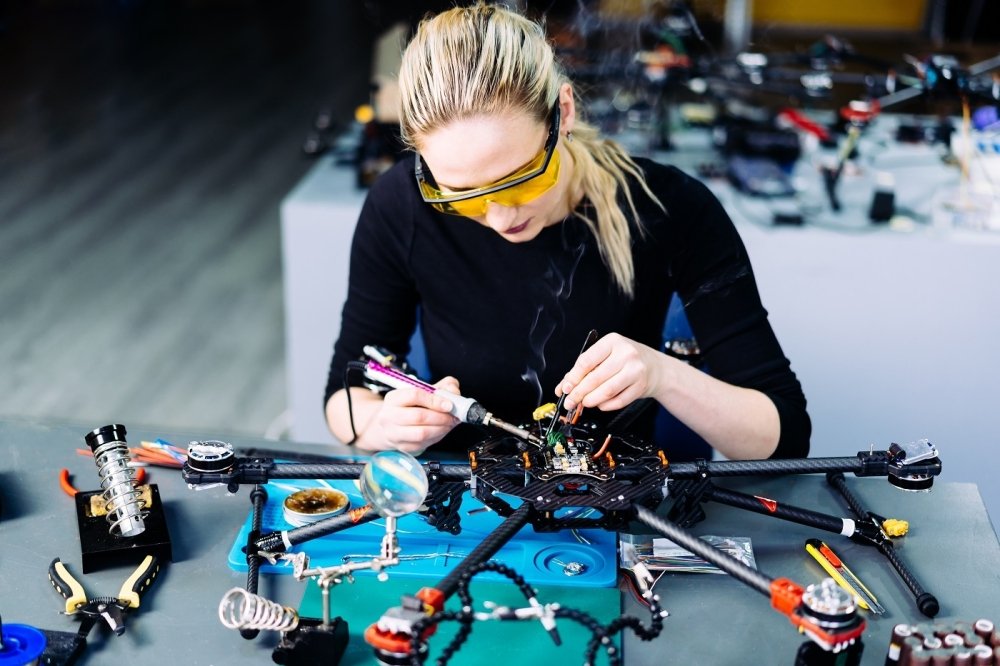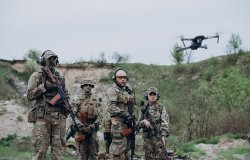
A blog of the Kennan Institute
What Wedding Drones over Ukraine Can Tell Us about the War

RZ Images - Shutterstock - https://www.shutterstock.com/it/g/xTeraphim
A married couple in line at the post office in Kyiv is chatting about delivery:
"I need to pick up kamikaze drones for my buddies," says a man in his mid-30s.
"The little ones?" his wife clarifies.
"Well, yes, the ones that used to be called 'wedding drones,'" he explains.
For residents of large Ukrainian cities, talk of buying and delivering drones has become commonplace since the full-scale invasion began. The drone is the main aim of crowdfunding campaigns, from small and large organizations to private initiatives. On the trendiest streets of Kyiv, drone fundraising posters can be seen next to concert announcements and military flyers.
Why is Ukraine constantly raising money for drones, why is there a constant shortage of them, and how do drones extract victories at the front? I talked to the main experts on the development of military technology in Ukraine and military personnel who use these small, remote-controlled rotorcraft on the battlefield, via video call last month.
Ever since leaders of public organizations and the country's leadership began to popularize drones for use on the front line, people's attention to them has increased many times over. However, finding the resources to implement these tools is still very difficult.
On August 19, the Russian army launched a missile attack on the drama theater in downtown Chernihiv, where a conference called Lyuti Ptashky (Crazy Birds) was being held, which brought together drone manufacturers and aerial intelligence schools. Only the participants of the event knew the exact location, but the information was somehow leaked to Russian intelligence—and the target of the attack was later confirmed by Russia's propaganda media. The attack left seven people dead and 174 injured.
The attack was a personal tragedy for one of the organizers of the conference, Maria Berlinska, a popularizer of military technology and founder of the largest organization that raises money to buy drones and teaches Ukrainians how to use them on the battlefield. For years she has been promoting the need for introducing technology in warfare, in Ukraine and around the world. In drones, she sees the possibility of the most effective intelligence and defense with minimal harm to humans.
"In March 2022, I wrote about the need to advocate for [high-tech] weapons, and I was told [by the country's leadership] that I was surrendering state secrets when I asked for weapons,” Berlinska told me in an interview. “But I understood then that in a few months we ALL would have to advocate for weapons, because it is impossible to win such a war with Stingers and Javelins."
When did the power of drones become known?
Drones have long been looked upon as a major driving force in military technology. Yaroslav Honchar, founder of the Aerorozvidka (aerial intelligence) nongovernment organization that pioneered the use of drones in warfare in Ukraine, recalls how this became evident in 2014. It was then that the Chinese company DJI released its first mass-produced drone, the Phantom. It could only fly at a range of 300 meters, but it was easy to buy.
"At the beginning of the war in Donbas, my buddy was surrounded in Luhansk, and he happened to have a drone," Honchar told me. "He flew the drone from ambush to ambush—and in this way he led an entire unit to a safe place. When he came back from the war, he said: everything we knew before should be thrown away and forgotten. The army is blind, it sees nothing and does not understand what is going on, and this is the biggest problem. The chain of command and friendly fire—all the effects that come from not being able to see beyond that—cling to that."
During the same period, Berlinska started studying military technology and popularizing drones. It was not an easy path for her, as she was not a "techie" type, she said, but she became so convinced that drones reduce deaths in the military and make the use of weapons many times more effective that she decided to devote herself fully to the new cause. Now she says that if Ukraine doesn't watch Russia develop drone production and invest in new technologies to have an advantage on the front lines, and doesn't seek to develop this industry itself, it will lose the war.
Honchar says the use of robotic systems has boomed in Ukraine over the past two years. He says the army uses hundreds of different systems every day, and they are not only flying drones, but also sea and ground drones.
The military drone operators I spoke to cite the following challenge: two drones cost about the same as one pickup truck. In a situation of constant advancement into enemy territory and the need for incessant reconnaissance, you have to choose whether to save yourself with a pickup truck or with a drone. These military officers argue that a drone is always better, because if you have "eyes" that can look far ahead and scout out a potential ambush, you don't have to escalate the situation to a rescue mission.
"A drone is an active-duty ambush. By flying a drone up and scouting the situation, you can find out that you don't even have to start the engine of a pickup truck," explains a military officer involved in drone deployment in the Armed Forces of Ukraine. “In addition, the drone can become a combat drone if necessary, and hit the enemy."
How many drones does it take to win a war?
"The war of the third millennium looks like the war we are waging," Honchar, head of the aerial intelligence organization, said. “This is the biggest armed technological conflict in the last 50 years—in terms of the number of resources, means, technologies involved. The Ministry of Digital Transformation of Ukraine accepted for delivery about 80 different types of drones, which have already been distributed to the troops, having been approved through official procedure. And in addition to them, there are also 'wedding drones'—a huge segment that is used unofficially."
One of the most popular drones that Ukrainians are collecting donations for every day is the DJI Mavic 3. It costs about $3,000, and military personnel working with the drone say it is the cheapest and best-quality option for use on the battlefield. “Anything that costs less is used mainly for training,” says a source in the Ukrainian Armed Forces. According to him, such a drone lasts for three days in the high intensity of battle.
FPV drones—so-called "wedding" drones—are also massively used. They are also called kamikazes, as they do not return from their targets. Such drones cost $500. They are retooled for combat purposes, and if used skillfully, they can hit equipment worth several million dollars.
Since the full-scale invasion began, drone operators have been integrated into all military units in Ukraine. Tens of thousands of people have been trained at various schools across the country. For example, Berlinska created the Victory Drones military training program, where 150 trainers have taught the technology to 35,000 people. Now the flow is approaching 5,000 people a month. The Ministry of Digital Transformation, through a network of partner drone schools, has trained more than 10,000 military personnel.
However, the state does not buy drones and cannot officially have them in service, because the Ministry of Defense and parliament have not yet adopted a new military doctrine, which would include the new technological warfare. "We have the Ukrainian paper army in operation," explained Honchar. "This is classic bureaucracy: if you don't have an approved instruction on how to work with drones, you actually don't have many options. The current official doctrine has not kept up with technological advances."
What is the future of war?
"This kind of armed confrontation is happening for the first time in the history of humankind in terms of scale and technology," said Honchar. "We are on the verge of epochs, and we are already entering the information age. At the same time, our 10-year experience of positional warfare has taught us that we should constantly strive for new techniques, change tactics, and try innovations, because this is what drives progress and helps us to repel attacks in a more sophisticated way."
Both Honchar and Berlinska, as well as drone operators in the Armed Forces of Ukraine, say that the processes in the Ukrainian army are far from ideal. The army often spends too many resources to hit the target, and in conditions of constant resource scarcity, this is critical. Changes are needed on several planes at once. "I call it the triangle: people, technology, and processes," said Honchar. “If we forget about people and processes and talk only about technology, it’s meaningless. You need trained pilots, and you also need them to be able to interact with each other. This is sometimes more important than having some kind of technology. If the crew isn’t trained, there’s no point in what kind of drone they have. And if the command can’t establish coordination between crews, there will be ‘friendly fire.’"
Most drone organizations in Ukraine are busy calculating how to make the use of new technologies most effective in the fight against the large, aggressive armies of Russia and Belarus. According to Honchar, it's about metrics, to see how time, money, and resources are being spent—and based on that data, seeing how they can be improved. An adversary with nuclear weapons and greater military resources forces one to think creatively.
Ukraine's main goal, according to those involved with drones, is to accelerate the pace of military action. "Whoever is faster wins. We are literally talking about minutes," Honchar said. Berlinska said that strength is in knowledge. The more people in Ukraine know the language of technology and apply it in different spheres, the faster progress—and potential victory—will be achieved.
The opinions expressed in this article are those solely of the author and do not reflect the views of the Kennan Institute.
See our newest content first.
Subscribe to receive the latest analysis from Focus Ukraine.
About the Author


Kennan Institute
The Kennan Institute is the premier US center for advanced research on Eurasia and the oldest and largest regional program at the Woodrow Wilson International Center for Scholars. The Kennan Institute is committed to improving American understanding of Russia, Ukraine, Central Asia, the South Caucasus, and the surrounding region though research and exchange. Read more










